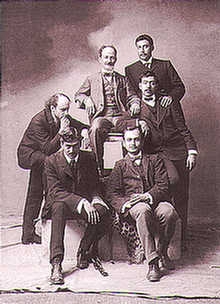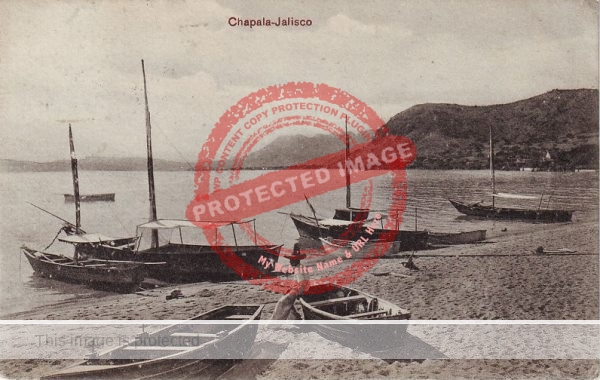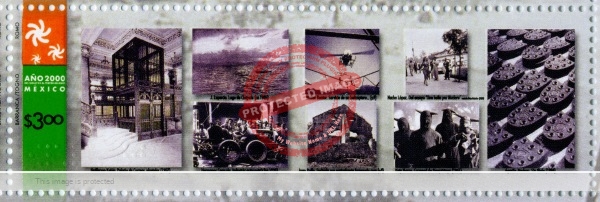Mexican photographer José María Lupercio (1870-1929) took numerous outstanding photos of Lake Chapala at the start of the twentieth century.
Lupercio was born in Guadalajara on 29 December 1870 and was one of the most noteworthy Mexican photographers of his era. Lupercio was one of several fine photographers whose work reached a wide audience because it was used for many early picture postcards of Lake Chapala. While Lupercio was 100% Mexican, many of the other photographers whose images of Lake Chapala illustrated postcards in the early twentieth century—including Charles Betts Waite, Hugo Brehme and Winfield Scott—were foreign-born, as were most of the postcard publishers.
José María Lupercio began his artistic career by studying painting in the Guadalajara studio-workshop of the Brazilian artist Félix Bernardelli, where he was a classmate of such distinguished artists as Gerardo Murillo (Dr. Atl), Rafael Ponce de León and Jorge Enciso.

Bernadelli and friends, 1898
Lupercio developed his photography skills by working with the commercial photographer Octaviano de la Mora (1841-1921) who had his studio in Guadalajara. Despite his humble background, De la Mora, born in Ixtlahuacán de los Membrillos, became one of the most renowned early commercial photographers in Mexico. The quality of his portraiture work was praised by contemporary critics and won him a major award in the third Paris World’s Fair in 1878.
Lupercio took over de la Mora’s Guadalajara studio, located in Portal Matamoros, in 1900 when de la Mora moved to Mexico City to work at the National Archaeology, History and Ethnology Museum. Some years later, Lupercio also moved to Mexico City, and again stepped into de la Mora’s shoes when he took over as the museum’s resident photographer after de la Mora retired.
During Lupercio’s time in Guadalajara he shifted the emphasis of the studio’s commercial work away from the formal portraits initially favored by his mentor towards landscapes and photographs of people posed in their natural, day-to-day surroundings. According to an editorial mention in a local English-language paper in 1904, “José Lupercio, the photographer in Portal Matamoros, offers some beautiful views of the city and republic. His portrait work is unrivalled.”

José María Lupercio. Chapala. c 1905. Published by Juan Kaiser.
Lupercio’s talents brought him great success and he won numerous national and international awards for his work, including a diploma from the French Photographic Society (1898), a silver medal from the 1900 Paris Exposition, a silver medal from the 1901 Panamerican Exhibition in Buffalo, New York, and a gold medal in the 1904 Saint Louis Exposition in Missouri.
The latter achievement was the basis for the text of a 1906 ad for Lupercio’s studio: “Honor for Guadalajara! Native Types of Mexico Took First Premium at St. Louis Exposition. – Lupercio’s – The Finest Views of Guadalajara – Photographs of all Kinds. – José Lupercio, Portal Matamoros #9, Guad.”
Lupercio was a founder member of the Ateneo Libre de Controversias Literarias, Artísticas y Políticas founded by Dr. Atl in Guadalajara in 1916, along with José Othón de Aguinaga, Antonio Pérez Verdía, Ixca Farías and several other local artists and intellectuals.
Many examples of Lupercio’s photographs of Lake Chapala are preserved in the National Archives. More than a dozen of his Chapala photographs were published as postcards in the first decade of the twentieth century, mainly by either Juan Kaiser or Ruhland & Ashclier, though Lupercio also sold his work to several other publishers. Some of the finest images of Chapala taken by Lupercio were used by little-known local publisher Manuel Hernández for postcards printed in Austria, which are of exceptional quality.
In the year 2000, one particular photograph of Chapala, taken by Lupercio in about 1906, was accorded the rare distinction of being included on a Mexican postage stamp to commemorate the importance of photography in Mexico during the twentieth century. Somewhat surprisingly, this 2000 issue was the first time Lake Chapala had been portrayed on a Mexican stamp.

Mexican postage stamp (2000) with Lupercio photograph of Lake Chapala, c 1906.
In 1916, Lupercio was appointed the official photographer at the National Museum in Mexico City. He subsequently took thousands of photographs of archaeological pieces and other items in the museum’s collections. He also photographed the artwork of his former classmate Dr. Atl in the Escuela de San Pedro y San Pablo, the paintings of Saturnino Herrán, the murals of Diego Rivera and took portraits of many of the celebrities of the time, including Rivera, Atl, Manuel Toussaint, José Vasconcelas and other prominent intellectuals.
Lupercio maintained a private studio in Mexico City at Avenida Madero 42 and began to produce postcards for sale in the National Museum. The postcard photographs portrayed ethnographic themes as well as ancient codices, archaeological sites and historic monuments. His production was prolific. For example in 1922, he produced no fewer than 2,564 different postcards! But this was not even his peak level of activity. Astoundingly, between July 1925 and July 1926, he produced 8,229 distinct postcards!
Ever an adventurous individual, Lupercio not only found time for his painting and photography but also worked on theater sets and participated in bullfighting, car racing and flying.
Examples of Lupercio’s superb photographs are preserved in many public and private collections, including those of the Instituto Cultural Cabañas in Guadalajara, the National Anthropology Museum in Mexico City and the National Archives in Pachuca, Hidalgo.
Lupercio remained the official photographer at the National Museum until his death in Mexico City on 2 May 1929.
My 2022 book Lake Chapala: A Postcard History uses reproductions of more than 150 vintage postcards to tell the incredible story of how Lake Chapala became an international tourist and retirement center.
Note: This post was first published 2 July 2019.
Sources:
- Raúl Aceves. 2005. “La tarjeta postal ilustrada en México durante la época clásica (1896-19015).” Boletín Filatélico Guadalajara, Año 8, No 17, 2005, 3-19.
- Arturo Guevara Escobar. 2011.”Letra L. Fotógrafos y productores de postales” Blog Post, dated 10 November 2011.
- Francisco Javier Ibarra. 2005. “José María Lupercio: espejo de la memoria IV.” El Informador, 24 July 2005, 13-B.
- El Informador: 27 February 1966.
- Jalisco Times: 14 May 1904; 5 January 1906.
Comments, corrections or additional material related to any of the writers and artists featured in our series of mini-bios are welcomed. Please use the comments feature at the bottom of individual posts, or email us.
Tony Burton’s books include “Lake Chapala: A Postcard History” (2022), “Foreign Footprints in Ajijic” (2022), “If Walls Could Talk: Chapala’s historic buildings and their former occupants” (2020), (available in translation as “Si Las Paredes Hablaran”), “Mexican Kaleidoscope” (2016), and “Lake Chapala Through the Ages” (2008).
wow–what a history and man–wish I could see even more clearly when you turn back the clock but am grateful for these glimpses —